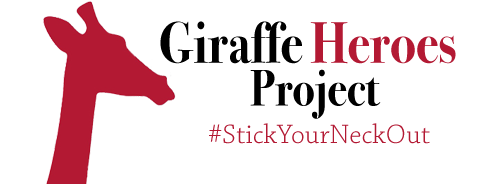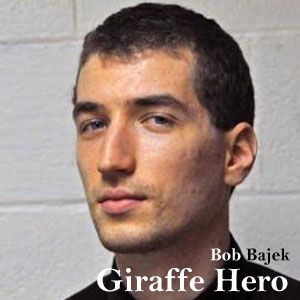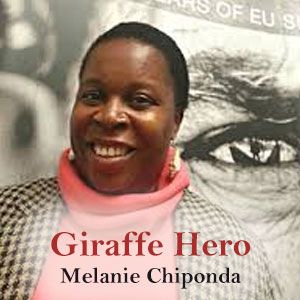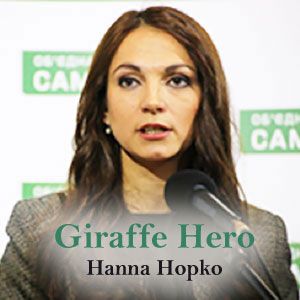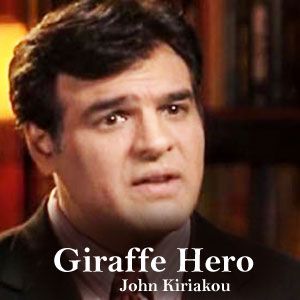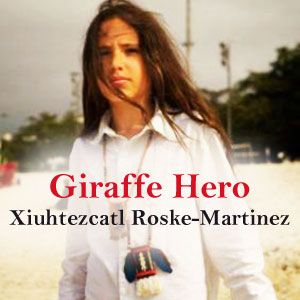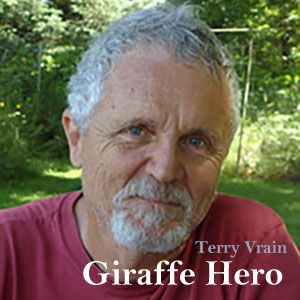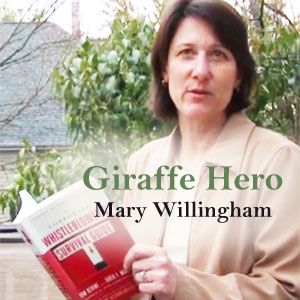Find a Giraffe
There are over 1,400 entries in our free database of real heroes, all of them about people who have stuck their necks out for the common good.
You can search there for Giraffes by name, location, problem addressed, age, gender, and occupation.
And you’re free to use our profiles of these heroes—with attribution, in the form of a link back to www.giraffe.org.
HAVE YOU SPOTTED A GIRAFFE HERO?
The Board of Directors of this nonprofit chooses new Giraffe Heroes several times a year. If you’ve spotted a hero you’d like to nominate, please go to our Nomination Page
A Few Examples of Giraffe Heroes
Bob Bajek
“Journalism is about seeking the truth. That is why I wanted to be a journalist.”
That’s Bob Bajek, a small-town reporter who has been seeking the truth about a neighborhood lake that’s been seriously polluted for years—he's been blocked at almost every turn from getting the story out.
Rantoul, Illinois, is a village of about 13,000. Residents often use HeritageLake for recreation. The problem is that HeritageLake used to be a sludge pit adjoining the Chanute Air Force Base. The base has been closed for years, but back in the 1960s, an airman buried a mixture of herbicides in HeritageLake; the mixture is now known as Agent Orange, a toxic defoliant used in the Vietnam War that causes severe damage to humans who come into contact with it. Bajek interviewed the airman, and the Air Force has admitted that Agent Orange was used at Chanute.
There’s more. Several decades after the lake was polluted, the town of Rantoul burned buildings it had purchased from the Air Force; the buildings contained asbestos, and the environmental problems caused by the burning were never addressed. Rantoul paid fines to the Illinois Environmental Protection Agency but no efforts were made to protect residents’ health before the burning nor to look into any resulting health problems in the community.
moreMelanie Chiponda
When the “diamond rush” struck the impoverished populace in 2006, thousands of poor Zimbabweans flocked to the Marange district in the country‘s Manicaland Province in a desperate attempt to “get rich quickly”.
The fortunate ones became instant millionaires whilst the unlucky perished from injuries inflicted upon from dog wounds and multiple bullet wounds fired by “trigger happy” state security agents under the guise of maintaining “law and order”.
Everyone was kicked out of the diamond fields leaving the army and a few powerful politicians with the assistance of Chinese companies to be in charge of mining operations.
However, all these threats did not deter one lady, Mellanie Chiponda to stand up and demand justice and transparency with regards to the mining of the precious stone. As a native of the diamond rich area Melanie got concerned with the gross human rights abuses that characterized the mining operations. According to her own testimony, she went on to quit her government job at the Registrar General’s offices to concentrate on fighting for the rights of the people.
“I was working in the government in the Registrar General’s office and at one time I was warned to desist from talking of the diamond issue to the press. I then decided to quit as a result and began advocacy work for the people who were being abused,” said Melanie.
moreHanna Hopko
This is how you make a revolution. At least, this is how Hanna Hopko is helping make a revolution in Ukraine.
You start by building your credibility: You get a Master’s Degree in International Journalism and a Doctorate in Social Communications. You become an ecological journalist, conducting trainings, speaking at conferences, and heading up governmental and non-governmental committees. You publish articles and appear throughout the media. You take over as the Communications Manager of the Ukraine Citizen Action Network. You act as the Advocacy Coordinator of Ukraine’s Campaign for Tobacco-Free Kids. You co-found and take the office of Deputy Director of the Regional Advocacy Center. You join the board of the Anticorruption Action Center. And you coordinate the “Reanimation Package of Reforms” (RPR), dedicated to ridding the country of corruption, and redrafting national laws to create free, fair, and honest government.
You do all this by the time you’re 32.
You also put your life on the line. You join with other Ukrainian citizens in a massive protest against the corrupt and unresponsive regime of President Victor Yanukovych and his efforts to pull the country back from a closer association with the countries and economies of Western Europe. Yanukovych flees the country, but not before his gunmen kill many of the protestors. Your car is destroyed, and you receive threats on your life.
moreJohn Kiriakou
There are some professions—surgeon, firefighter, parachute jumper—in which you really don’t want to make a mistake. Add to that list “CIA operative.” John Kiriakou found out the hard way.
Kiriakou’s CIA resume was sterling: Middle East analyst, economic officer, foreign-agent recruiter, Chief of Counterterrorist Operations in Pakistan, leader of raids against al-Qaeda, and even the target of assassins. In 2004, he resigned from the CIA with a multitude of awards, medals, and other honors.
Kiriakou joined an accounting firm and later became a terrorism consultant for ABC News, a senior investigator for the Senate Foreign Relations Committee, a managing partner of a consulting firm, an author, and a speaker. And then, in 2007, came the ABC News interview during which he described waterboarding as “torture.” That statement put him in demand as a guest expert on news and public affairs shows. He was the first U.S. government official to confirm the use of waterboarding al-Qaeda prisoners as an interrogation technique, and he was also the first to label it as torture.
The mistake that technically got him in trouble occurred several months later. At a reporter’s request, he offered the name of a former CIA interrogator. The interrogator was supposedly retired, never served under cover, and had already placed his personal information on a public website. However, Kiriakou told the reporter that the interrogator had participated in a CIA operation that the government later claimed was classified.
moreXiuhtezcatl Roske-Martinez
Xiuhtezcatl Roske-Martinez loves the outdoors. Maybe it’s the Aztec genes passed on through his father’s side of the family; maybe it’s the environmental activism modeled by his mother. Or maybe it’s just that the forest around Boulder, Colorado, is stunning, and Xiuhtezcatl has grown up loving it.
Whatever the reasons, when he was only six years old, Xiuhtezcatl realized that something was happening to his forest, and that something wasn’t good. It was getting warmer, the trees were dying, the logs were feeding huge fires, plant growth was disappearing, and species of animals were becoming endangered.
The changes are so real and so serious that 6-year-old Xiuhtezcatl gave a speech at a rally that was organized to make people aware of the human causes of climate change. It's not abstract for him, and his up-close and personal familiarity with the forest holds him in good stead with climate change-deniers, as well as others who may deride him for being overly concerned. “The proof,” he says, “is right in front of us. This is happening now, this is happening here, and this is real.”
Xiuhtezcatl has been working for the environment ever since that first speech, particularly as the voice of the Earth Guardians, a nonprofit environmental group for youth.
moreTerry Vrain
Let’s begin with a little science, courtesy of Dr. Thierry Vrain, research biologist:
“When we started with genetic engineering in the 1980s, the science was based on the theory that one gene produces one protein. But we now know, since the human genome project, that a gene can create more than one protein. The insertion of genes in the genome through genetic engineering interrupts the coding sequence of the DNA, creating truncated, rogue proteins, which can cause unintended effects. It’s an invasive technology.”
Why is this important? It’s important because these days many common foods are “genetically engineered” to increase crop yield and to become more resistant to insecticides, both laudable goals. But many people, including Vrain, now believe that the “rogue proteins” being used are potentially unhealthy and even dangerous to anyone who eats those foods.
Thierry Vrain knows what he's talking about: He’s a former genetic engineer himself, with a doctoral degree in plant physiology. He worked for 30 years as a research scientist for the Canadian government, genetically engineering small fruits and potatoes, and directed the biotechnology department at British Columbia’s Pacific Agri-Food Research Centre. The Vrain of the past was the kind of scientist the Vrain of the present is arguing against.
moreMary Willingham
As academic advisor to student athletes at the University of North Carolina (UNC), Mary Willingham assumed that the purpose of the university to educate its students, such students including the athletes she was advising.
Based on the university’s reaction to her findings on how they were doing that job, such an assumption was perhaps naïve.
Willingham, a reading specialist, conducted research on 183 UNC-Chapel Hill football and basketball players from 2004 to 2012. She found 60% of them reading at fourth- to eighth-grade levels and 10% reading at below a third-grade level.
But there’s more. Willingham and others have found many “irregularities” in UNC’s curriculum when it comes to athletes: coursework requiring only a “research paper” and no other submission for a grade; tutors writing those papers for student-athletes; classes that never even met. And in over a decade working at UNC, Willingham herself has worked with athletes who could not read or write. One student even asked her to teach him to read well enough to follow news reports about his games.
None of this was a secret, of course. The idea of pushing athletes—regardless of their skills and knowledge—into classes where they could get grades sufficient to remain eligible for sports was well-known, not only at UNC but at many “educational” institutions throughout the country.
moreSubscribe to Heads Up, our once-in-a-while-emails
You can be the first person on your block to know who the new Giraffe Heroes are. Just subscribe to Heads Up, our only-when-it-matters emails. The Giraffe Heroes Project is compliant with the new privacy rules established by the European Union. We invite you to check out our Privacy Policy here. We protect your data and we don’t sell or lend our subscribers’ addresses to anyone. Ever.

This work is licensed under a Creative Commons Attribution-NonCommercial-NoDerivatives 4.0 International License.
